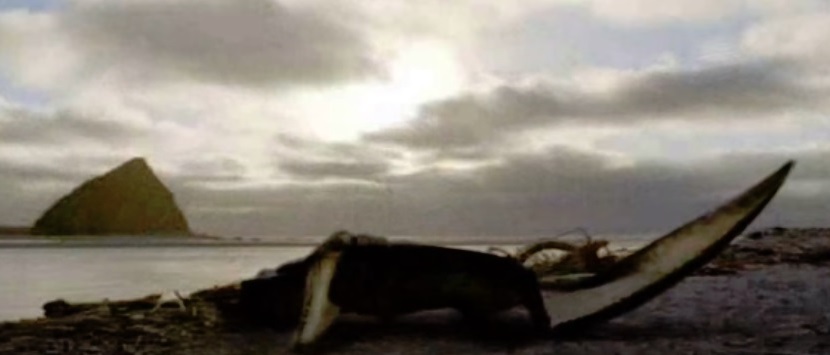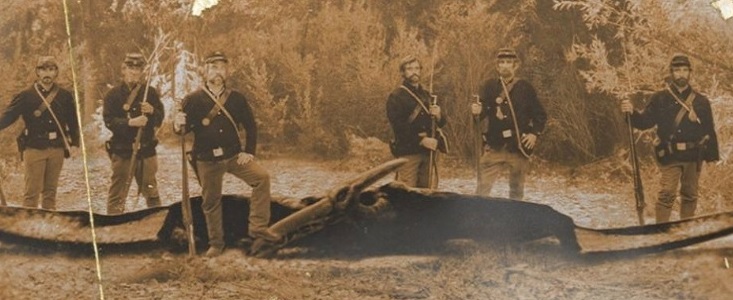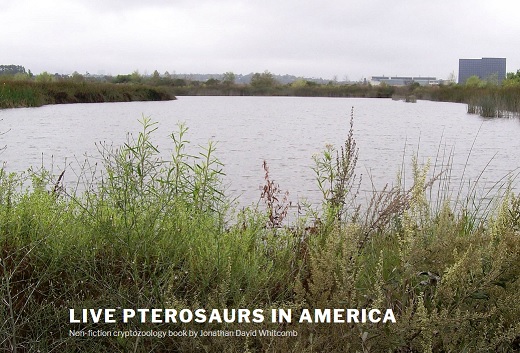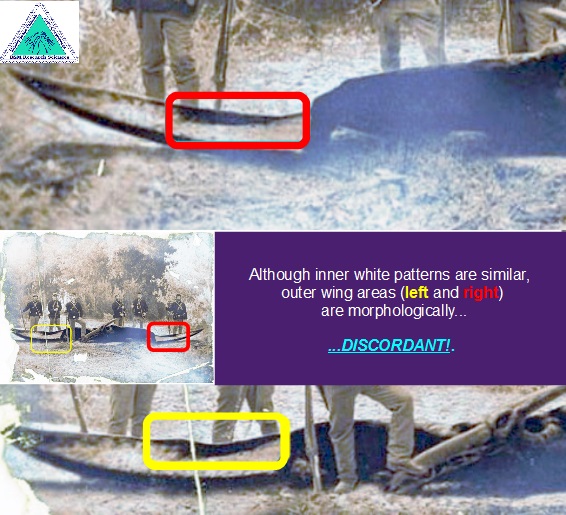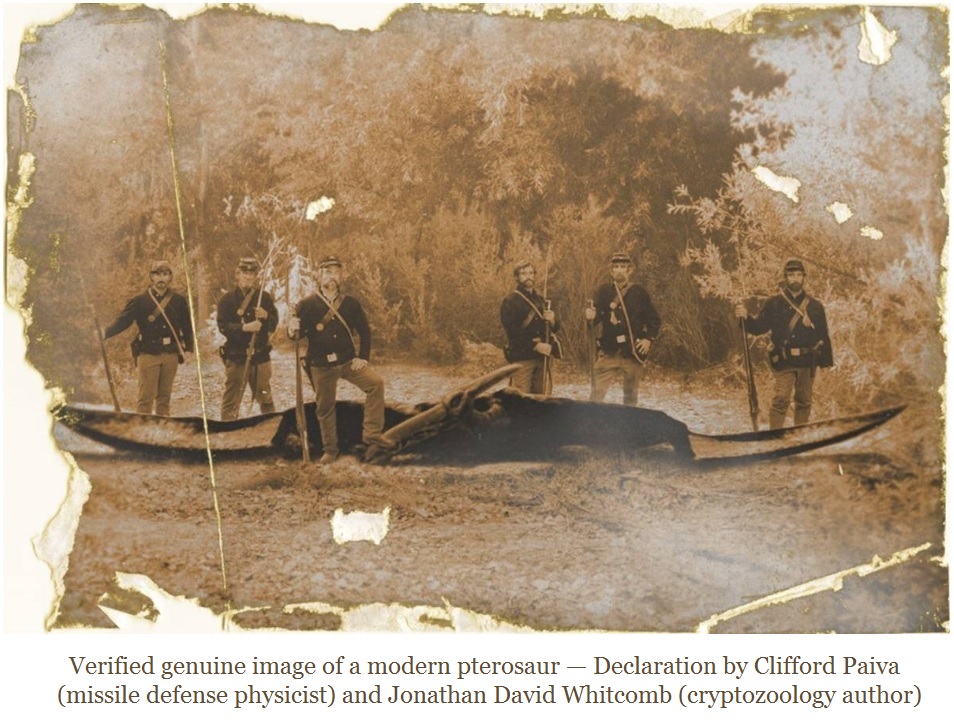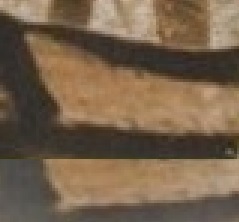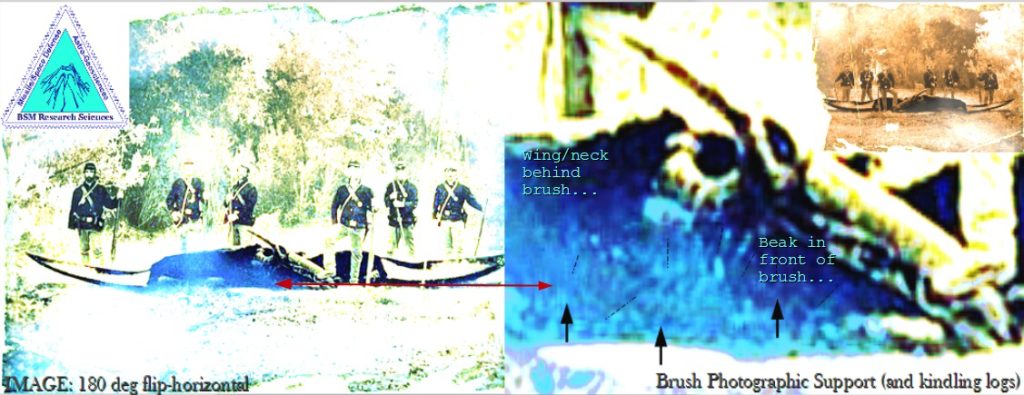By modern-pterosaur expert Jonathan Whitcomb
I hate to think what life would have been like, for me and my associates, for these many years, if we had never encountered any skeptical remarks or any criticisms of any kind regarding our investigations of reports of encounters with apparent modern pterosaurs. We could have fallen into carelessness in many aspects of our work, for some skepticism can be healthy. Yet people need to be careful when they criticize or put words to their doubts. I think there’s a difference between scientific skepticism and other kinds.
This is a partial response to some of what has been written by Glen Kuban. I begin by addressing a couple of concerns that Kuban has had about publicity for the Ptp photo (that which shows an apparent modern pterosaur). I’ll then mention four concerns I have about some of the problems I see in his online publication “Living Pterosaurs.”
.
The Ptp “Civil War” photograph
Not all of Kuban’s writings are on his long online article “Living Pterosaurs (Pterodactyls)?”, and we’ll now look at two concerns that he has written about in some of what I’ve recently read outside that online publication.
You say the photo was “published” by Underwood and Underwood, but give no citation or information on where it was published . . .
That’s a good point. Yet I was not trying to be misleading in leaving out where I found the Ptp version that has a border. It was only eight days ago that I noticed “Underwood & Underwood” on the left side of the border of the photograph and I became so excited that I began writing about the discovery right away. I then spent day after day researching possible leads for more information, hoping to find out what book had been published with that early version of the photo. That’s where I made a mistake, a time-consuming blunder.
I had assumed that I would be able to quickly locate the online source, but I neglected to consider that I had spent hours in my original online searching before I found that photo with a border. (I was not expecting to find a version of Ptp with an old cardboard border around it; I was just looking for some early source for some kind of publication.)
When one or two persons asked me about the source, earlier this week, I realized I had not written down the URL. I then spent over an hour in the same kind of online searching I had done the previous week. Unfortunately, I had also forgotten exactly what words I had used in my searching that led me to find the pterosaur-photo with the border. Fortunately, I then remembered that I had done a screen capture, and I was able to get the information that led to me finding it again.
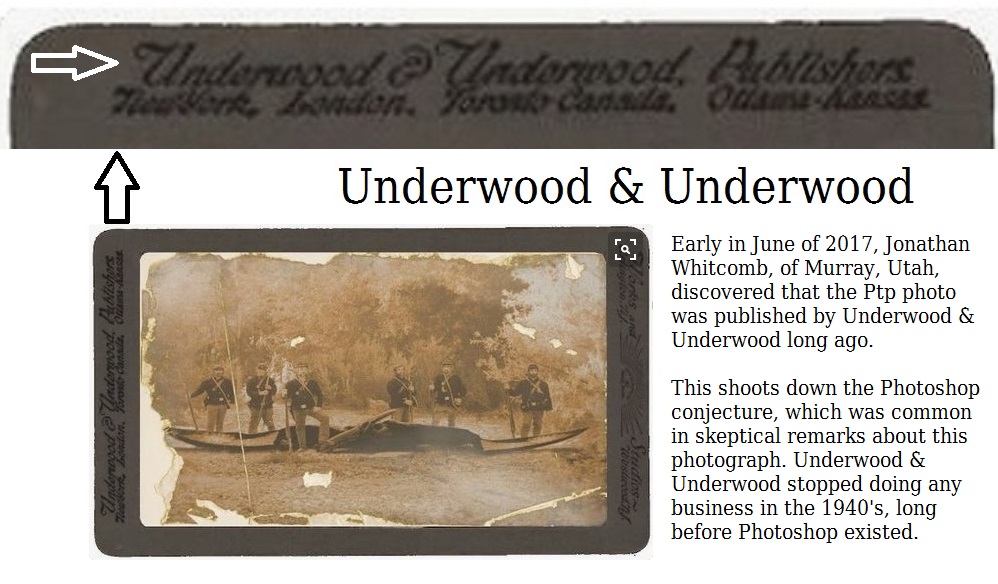
Underwood & Underwood “published” this old photograph many decades ago
Before I give the URL’s for this photo with a border, we need to be clear about the word published. This is not my choice of wording but is what is printed on photograph’s border itself. Look at the above image, on the top-right. After the company name, it says, “Publishers.” What they meant was surely this: They were making copies of photographs and distributing them. They were not publishing books or magazines but apparently were using the word publishers differently. Kuban seems to have been confused by that word usage, a few days ago, but I trust he now understands it.
Here is one of the online sources: Civil War monster shot
Here’s another source, although it’s obviously related: Photo of a strange winged monster
I may have seen one more similar Pinterest sources, but those two URL’s should suffice for now.
Kuban has recently been concerned about my frequent use of the phrase “Civil War” when referring to Ptp. I believe, however, that most of those who carefully and thoroughly read a number of my writings on this subject will have little, if any, problem understanding the stand Paiva and I are taking.
We are keeping an open mind regarding exactly when the photo was taken, although Paiva and I are leaning towards the idea that it was slightly after the end of the Civil War.
Why do I often use the phrase “Civil War” in my writings? For one thing, that is how many readers think of it, for those soldiers are indeed dressed very much like soldiers of the American Civil War. Kuban seems to have become upset by what he feels are contradictions in my writings, because of the phrase “Civil War,” but I don’t know of any other person who has had any problem with this.
.
Four Concerns With “Living Pterosaurs”
Let’s now consider four potential weaknesses (out of many) in Kuban’s long online article, one of them minor:
- Loren Coleman’s stand on Ptp: “Verdict: Photoshopping”
- Whitcomb’s stand on the Freakylinks hoax photo (a minor point)
- Out of focus: The Freakylinks fake photo is out of focus, not Ptp
- Kuban says “dye or stain cloth wings” (or hide) over wooden wings?!
.
Loren Coleman’s “Civil War Dinos” in Cryptomundo (Feb 16, 2007)
Loren Coleman’s old “Photoshopping” statement is still relevant, even though support for that conjecture is fading. In the June 9, 2017 version of “Living Pterosaurs,” Kuban admits:
. . . if the photo was in the U & U collection, this probably rules out any Photoshopping, although it would still allow manual photo editing techniques.
In other words, Kuban himself has started to set aside the Photoshop conjecture, choosing instead to point to the possibility of physical photo editing and/or physical modeling. I’m glad that he is beginning to see some light in that direction, but he misses a critical point: People have rejected Ptp because of the Photoshop idea.
Kuban mentions “confirmation bias” 13 times on his web page, with one long section having that heading. Much of that section is about my religious beliefs, or at least what Kuban thinks they are. What reader of that section of his “Living Pterosaurs” article would guess that it would be possible for someone to reject the Ptp photograph because of confirmation bias? Look deeper and take everything in context.
Loren Coleman has a “photograph” at the top of his “Civil War Dinos” post and says, “. . . Civil War soldiers with a Triceratops,” meaning the apparent dinosaur was inserted onto an old photograph through Photoshop manipulation. I don’t know of anybody who disputes that.
But look right under the fake-dinosaur image and see the Ptp photograph. Notice what’s right under that: “Verdict: photoshopping.” Those are the only words of explanation for Ptp: “Verdict: photoshopping.” We can’t examine Coleman’s brain under a microscope, but to me this certainly looks like a case of confirmation bias.
If Glen Kuban were entirely objective, he could have noticed that and added it to his section “Confirmation Bias.” I suspect that he himself has become overly focused on my religious beliefs, falling into a confirmation bias himself.
.
Whitcomb’s Position on the Freakylinks Hoax Photo
The June 9, 2017, version of “Living Pterosaurs” includes the following in a section called “‘Civil War’ Photos:”
Two other so-called “Civil War” photographs have recently been the subject of much discussion on the web, largely due to active promotions by Jonathan Whitcomb.
That could be misleading, should a reader not go further into those paragraphs. I have never promoted the authenticity of the Freakylinks hoax photo. Only the Ptp “Civil War” photograph have I promoted as an authentic photo of a modern pterosaur. I believe Kuban understands this and did not intend any deception. It was just not the best wording.
.
What Photo is out of Focus?
In the most recent edition of Kuban’s “Living Pterosaurs” web page, he says the following about Ptp:
Others have pointed out the suspiciously blurry and grainy nature of the photo, compared to the sharp focus of most photos from the time.
In reality, the Freakylinks hoax photo is blurry, NOT Ptp. If Kuban had only looked at the Ptp photo himself, with reasonable care, he would probably not have made that blunder. In fact, I remember reading only one or two places online where that out-of-focus idea is mentioned, and at least one of them said that the Freakylinks fake photo was the one that was out of focus, not Ptp. But Kuban gives no reference or URL for “others.”
The point is this: Professional photographs in the mid-to-late 19th century almost always had the main subject in sharp focus, and the men and the animal in Ptp are in sharp focus. This is one of the errors of fact that Kuban has made a number of times in “Living Pterosaurs,” errors of fact that can lead readers away from the truth. (For years, “Living Pterosaurs” had the Ptp image but referred to it as a hoax from a television show. Thank you, Mr. Kuban, for correcting that, this year.)
.
“Dye or stain cloth wings” (or hide) over wooden wings
Kuban gives no name of any expert who might support him in this conjecture. He also gives no reference or URL for anything that might support that idea.
He says, regarding the apparent biological structures in the two wings, “if animal hides were used, they would even be ‘biological.'” Why not look closely at those structures? Again, Kuban seems to neglect actually looking at the image itself or at least looking with an open mind. It’s not only in focus but the outer areas of both wings show structures that look nothing remotely like cloth or hide, whether or not any dye or stain was applied to it.
And why in the world would six men, or any number of persons in the 19th century, go to so much trouble to construct two long wings of a monster, using wood that was then covered with cloth or hide? And how would they know to make those wings fold in a similar way that real pterosaurs folded their wings? It’s far easier, in my opinion, to believe in a modern pterosaur than in the fantastic model construction suggested by Glen Kuban.
.
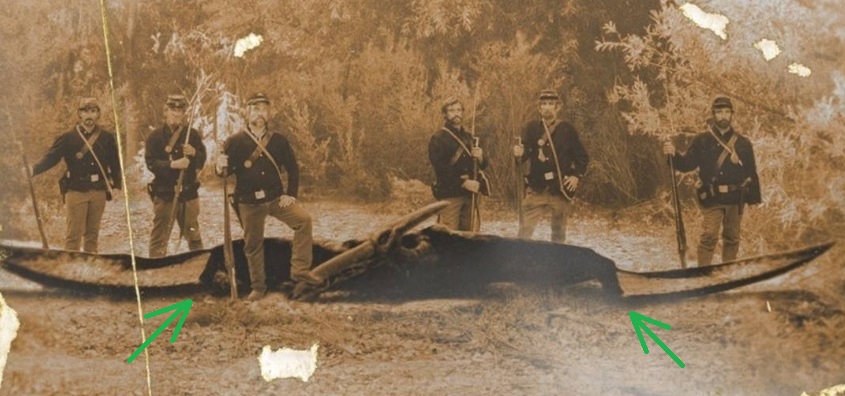
Wing folding in Ptp is direct evidence that this was a real pterosaur
.
Conclusion
Careful scientific skepticism can help encourage researchers and investigators and experimenters to remain disciplined in their work, but careless non-scientific criticisms can lead persons away from the truth, even when the careless skeptic does not intend to deceive or lead anyone astray.
I acknowledge that Mr. Kuban has made corrections in “Living Pterosaurs” when he has been informed of one or more errors of fact. He may very well make corrections in at least some of the points I have mentioned above. Yet severe bias can prevent the kind of progress that a person needs to make in coming to a thorough knowledge and understanding of the truth. I suggest that he and others conduct the kind of self-examination needed to recover from severe bias.
###
Copyright 2017 Jonathan David Whitcomb (“Living Pterosaurs and Skepticism”)
.
News Release – Modern Pterosaur
A forensic videographer has announced his discovery of an old source for the photograph that is labeled “Ptp.” On June 2, 2017, Jonathan Whitcomb, of Murray, Utah, found that the photo was published by Underwood & Underwood, which was a leading company in photography from the late 19th century until at least the 1920’s.
.
Monster with Civil War soldiers
. . . the head suggests it was a Pteranodon, but we stopped short of insisting it must be that species.
.
Pterosaur photo and skepticism
This is not a reply to scientific skepticism but to a skeptic who uses a variety of tactics to persuade readers of his online page to disregard anything that might appear to give credence to the possibility that one or more species of pterosaur is extant.
.
Confirmation bias, belief perseverance, and living pterosaurs
Glen Kuban (GK) and I have a few things in common. We’ve both been writing about reports of apparent extant pterosaurs (or those who believe in them) for a long time, and we’ve written a lot. . . . He believes that no species of pterosaur has survived into the past few centuries; I believe that a number of species live today.
